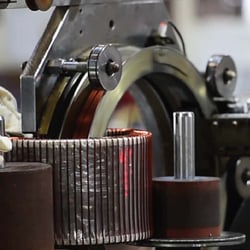Part one of the Planning, Scheduling, and OEE Mighty Trio series provides a brief summary of what OEE is and explains how one of the OEE data components – efficiency – can have a meaningful impact on planning, scheduling, and optimization. This edition explores using unplanned downtime data from OEE, and OEE efficiency data by SKU for planning, scheduling, and optimization.
This article is part two of a two-part series. Continue reading, or check out part one now.
Using Unplanned Downtime Data from OEE System for Better Planning, Scheduling, and Schedule Optimization
An occasional long unplanned downtime event can skew your efficiency multiplier. Let’s consider the example of equipment with 75% average efficiency. Several months of production data without any long unplanned downtime might be the basis for that 75% number. But when a long unplanned downtime event does happen – let’s say a four-hour unplanned repair – it translates to 50% capacity loss for an eight-hour shift. If the equipment is running at 75% efficiency, but your schedule is set for 100% capacity, the plant can only produce the equivalent of three hours of capacity instead of eight.
In this situation, one option is to log the unplanned downtime event in your APS to remove the capacity. An effective APS will automatically shift all future orders, adjust all the dependent operations on other equipment, and optimize all the orders according to business rules and constraints. A plant with 50 machines and 4,000 scheduled operations could easily mean hundreds or thousands of operations that the system automatically adjusts, simply when it sees the four hours of lost capacity you entered. Imagine trying to do that with an Excel spreadsheet … now consider that an effective APS usually does it within 2-10 seconds.
An important consideration about capturing unplanned downtime for your production schedule is to find out if your OEE system can provide an efficiency number that excludes long downtime events. The occasional four-hour unplanned downtime event – perhaps once every six months – won't affect your efficiency multiplier enough to worry about. But if a machine has that kind of unplanned downtime every week, excluding long unplanned downtime from the efficiency multiplier allows you to instead enter long unplanned downtime events in your APS. Keeping both would mean you’re removing four hours of capacity twice.
The most precise schedule ideally reflects micro stops in the efficiency multiplier and long unplanned downtime as manual entries on the production schedule.
If your production scheduling system is integrated with your MES or OEE system, it’s possible to enter long downtime events automatically so the APS can automatically optimize the production schedule. This can be a high-value tool if your plant has a large number of long unplanned downtime events.
OEE Efficiency Data Point by SKU for Greater Precision
So far, we've examined how the average efficiency can impact your manufacturing planning, scheduling, and optimization for a single machine or line. In reality, equipment performs differently for different products that it produces. A good OEE system won’t just track OEE by machine in general – it should also have the ability to report OEE and each of its component data points by SKU. For example, while one product runs at 73% efficiency, another might run at 86%. That’s a big difference, and knowing the efficiency multiplier by SKU can mean the difference between an "OK" production schedule and one optimized for actual machine capabilities.
If you have access to an effective APS, you can plug in a blanket efficiency multiplier for each machine or line, or an efficiency multiplier by SKU for that same equipment or line. It's a powerful feature for any high-volume plant, especially those that produce make-to-stock items. If your APS has both of these features, you can apply the correct efficiency multiplier for each order instead of using the base efficiency multiplier for that machine.
A word of caution about efficiency multipliers: Check how your APS handles them if it has a place for efficiency multipliers by resource and by SKU. Some systems will allow you to override one with the other, while other systems might apply both. When used correctly and as intended by the software vendor, efficiency multiplier by SKU can be a powerful method for manufacturing planning, scheduling, and schedule optimization with tremendous precision.
Next Steps to Leverage OEE for Better Planning, Scheduling, and Optimization
 If your company already uses OEE, you can tap into its rich OEE component data for a more precise, responsive production schedule and more accurate capacity utilization. We've touched on just a couple of ways to apply the efficiency data in your APS to make it an even more effective system. Whether your company chooses to integrate the MES/OEE system with its APS, you can still use the OEE data to supercharge your planning, scheduling, and optimization efforts.
If your company already uses OEE, you can tap into its rich OEE component data for a more precise, responsive production schedule and more accurate capacity utilization. We've touched on just a couple of ways to apply the efficiency data in your APS to make it an even more effective system. Whether your company chooses to integrate the MES/OEE system with its APS, you can still use the OEE data to supercharge your planning, scheduling, and optimization efforts.
If you already have an APS solution in place:
- Locate the standard rates entries in your system and determine if you can enter efficiency multipliers by machine, by SKU, or both. Also, explore how these entries work together and identify any conflicts that might develop if you make adjustments later.
- Find out how the plant calculates OEE. If it uses an MES or OEE system, then start looking for which efficiency data points are accessible.
- Before making any changes, talk with the stakeholders to map out the best approach for your company or plant and if using efficiency multipliers is a good approach.
If you’re evaluating APS solutions:








